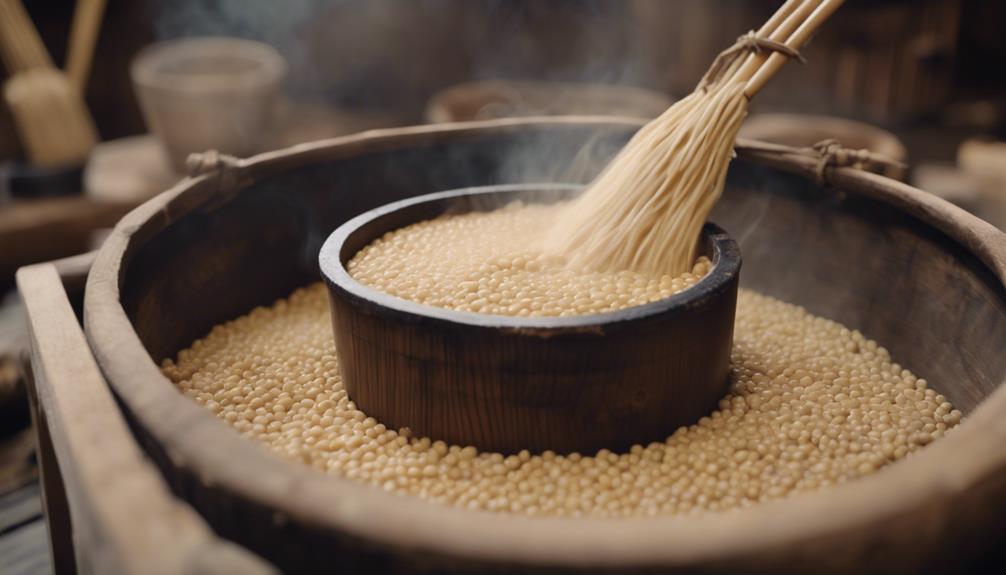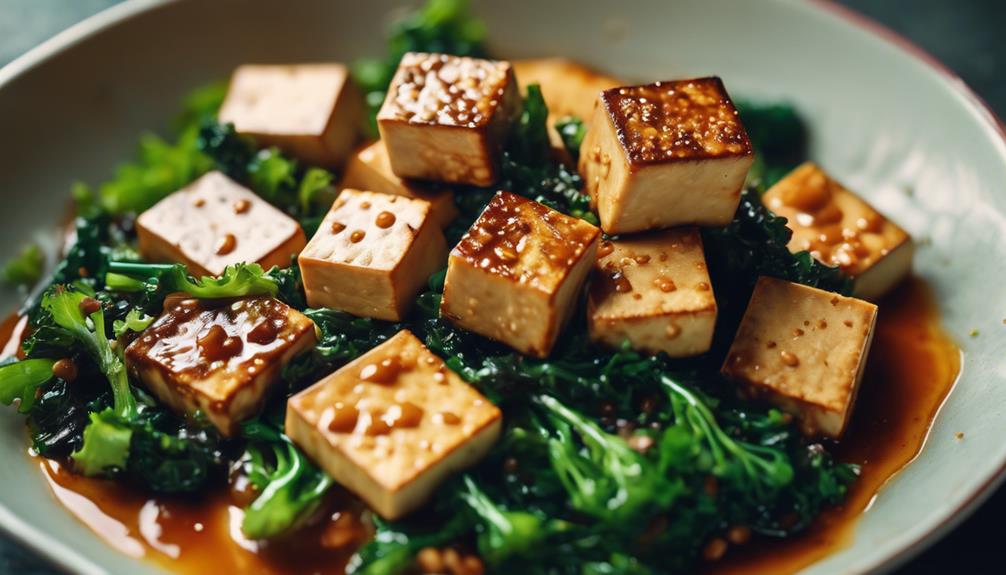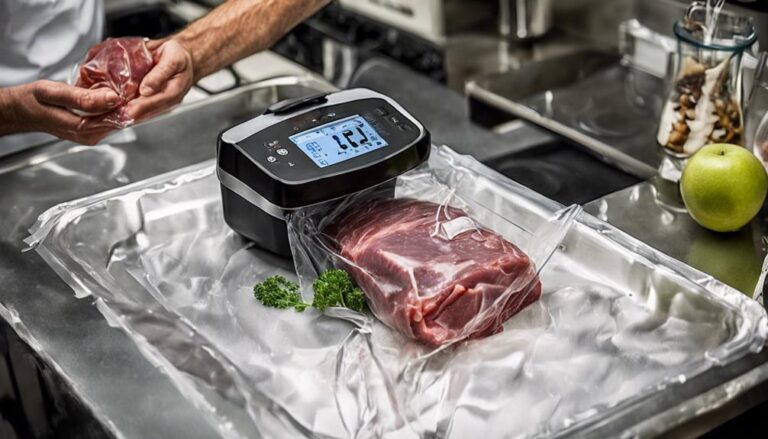Sous Vide Miso-Glazed Tofu With Stir-Fried Greens
Savor the succulent Sous Vide Miso-Glazed Tofu with a side of vibrant Stir-Fried Greens. The sous vide method assures tender tofu infused with the rich miso essence, heightening the flavors. The careful pairing with stir-fried greens adds a delightful contrast, enhancing your dining experience. Get ready for a explosion of flavors that will tantalize your taste buds.
What You Will Learn Here
- Sous vide cooking ensures tender miso-glazed tofu.
- Properly pressed tofu absorbs marinades for enhanced flavor.
- Stir-fried greens provide a vibrant contrast to the tofu.
- Miso's rich umami flavor permeates thoroughly in sous vide cooking.
- Pairing miso-glazed tofu with greens elevates the overall dining experience.
Miso's Ancient Origins

Miso's ancient origins trace back to the heart of Japan, where its discovery revolutionized traditional cuisine.
The meticulous fermentation process, blending soybeans, salt, and koji fungus, imbues miso with its distinctively rich and savory essence.
This culinary treasure not only adds depth to dishes but also reflects the deep cultural significance of miso in Japanese gastronomy.
Misos Historical Origins
Tracing back to the 3rd century BC in China, the ancient origins of miso reveal a rich history of fermentation and flavor. Miso, a product of fermenting soybeans with salt and koji mold, embodies centuries of culinary tradition. This process not only preserved the soybeans but also enhanced their flavor, creating a versatile ingredient valued for its ability to elevate dishes with umami richness.
As miso made its way to Japan around the 7th century AD, it became a staple in Japanese cuisine, offering not just taste but also essential nutrients. The regional variations in miso production highlight the diverse culinary landscape of Japan, with each area boasting unique miso varieties based on specific ingredients, fermentation techniques, and distinct flavor profiles.
Traditional Miso Production
With origins tracing back over 1,000 years in Japan, traditional miso production involves a meticulous fermentation process using soybeans, salt, and koji mold. The fermentation of miso paste is a time-honored craft that results in a versatile ingredient central to Japanese cuisine. Here is a brief overview of the fermentation process:
| Stage | Description | Duration |
|---|---|---|
| Mixing | Soybeans, salt, and koji mold are combined | 1 day |
| Fermentation | Mixture is left to ferment in vats | 3 months to 3 years |
| Aging | Miso paste is aged in wooden barrels | 6 months to 3 years |
This careful process creates the rich umami flavor and unique aroma that miso is known for, making it a cornerstone of Japanese culinary tradition.
Cultural Significance of Miso
The profound cultural roots of miso in Japan can be traced back over 1,300 years, marking a significant culinary legacy that continues to shape Japanese cuisine today.
Miso, a product of fermentation, was introduced to Japan from China as a method of food preservation. The process involves fermenting soybeans with salt and koji mold, resulting in the creation of miso's signature umami flavor.
This umami-rich paste holds a central place in Japanese culinary traditions, imparting depth and complexity to dishes like soups, marinades, and glazes.
The ancient origins of miso not only showcase its importance in Japanese gastronomy but also highlight the artistry and skill that have been passed down through generations, making miso a cornerstone of Japanese cuisine.
Miso Varieties and Flavors

Exploring the world of miso paste reveals a diverse array of types and flavors, each offering a unique culinary experience.
- White Miso: Known for its mild and sweet profile, white miso is perfect for adding subtle depth to dressings, marinades, and light soups. Its delicate flavor makes it a versatile option for those who prefer a more understated taste in their dishes.
- Red Miso: With a bold and salty taste accompanied by rich umami notes, red miso is favored in heartier dishes like stews, braises, and glazes. Its robust flavor profile can stand up well to strong ingredients, adding a savory punch to any recipe.
- Mixed Miso Blends: Combining various types of miso, mixed blends offer a harmonious balance of flavors. These blends are ideal for cooks looking for a well-rounded taste that can adapt to different cooking styles and recipes. Utilizing mixed miso blends can bring complexity and depth to a wide range of dishes, making them a versatile choice in the kitchen.
Tasty Miso-Glazed Tofu Creations
Get prepared to entice your taste buds with tangy miso-glazed tofu, a dish that bursts with savory and invigorating flavors.
Imagine sinking your teeth into tofu with a spicy miso glaze, adding a kick of heat to the umami-rich tofu base.
For a rejuvenating twist, explore the world of tofu miso spring rolls, where the creamy miso perfectly complements the light and crisp texture of fresh vegetables.
Tangy Miso Glazed Tofu
Enhance your tofu cooking repertoire with the delightful tang of miso glaze, elevating your culinary creations to new heights. The miso glazed tofu offers a high protein option that satisfies both taste buds and nutritional needs. When combined with vibrant stir-fry veggies, this dish becomes a flavorful and wholesome meal choice.
The umami-rich miso infuses the tofu with a depth of flavor that's both savory and slightly tangy. The precise sous vide cooking method guarantees the tofu's texture is tender and melt-in-your-mouth perfect. The miso glaze not only adds complexity but also balances the dish's flavors exceptionally well. This tangy miso glazed tofu is a delightful addition to your dining experience.
- High protein content satisfies nutritional requirements.
- Miso glaze enhances the tofu's flavor profile.
- Stir-fry veggies provide a fresh and crunchy contrast.
Tofu With Spicy Miso Glaze
With a tantalizing blend of spicy miso glaze, tofu transforms into a mouthwatering culinary creation that invigorates the taste buds. The spicy miso glaze not only adds a flavorful kick but also enhances the tofu with a delightful heat that lingers on the palate.
Here are three reasons why tofu with spicy miso glaze is a must-try dish:
- The miso paste offers a unique umami taste to the tofu, elevating its overall flavor profile.
- Customizing the glaze with varying levels of spiciness allows for a personalized culinary experience tailored to individual preferences.
- When paired with stir-fried greens, miso-glazed tofu creates a balanced meal that combines textures and flavors harmoniously.
Tofu Miso Spring Roll Recipe
Transform your miso-glazed tofu into delicious Tofu Miso Spring Rolls, offering a delightful twist on this tasty tofu creation. These spring rolls are a perfect balance of flavors and textures, with the marinated tofu providing a savory base complemented by the crunch of fresh vegetables and the aromatic herbs. The miso glaze infuses the tofu with a rich umami taste that elevates the overall experience of the spring rolls.
Here are three reasons why Tofu Miso Spring Rolls are a fantastic choice for a light and satisfying meal or appetizer:
- The combination of miso-glazed tofu and fresh ingredients creates a harmonious blend of flavors.
- Spring rolls offer a versatile way to enjoy tofu, allowing for endless customization possibilities.
- These spring rolls aren't only delicious but also packed with nutritious ingredients.
Tofu Pressing Techniques
Pressing tofu is a game-changer when it comes to enhancing its flavor and texture. By removing excess moisture, tofu can soak up marinades and sauces like a sponge, resulting in a more delicious end product.
Whether you opt for a tofu press, weighted plates, or paper towels, the pressing process is key to achieving firm and flavorful tofu dishes.
Tofu Pressing Methods
To achieve ideal tofu texture and flavor absorption, various methods can be employed to remove excess liquid effectively before cooking. Pressing tofu is an easy-to-make step that greatly enhances its ability to soak up flavors.
For extra firm tofu, which is excellent for high-heat cooking methods like grilling or sautéing, pressing is essential. Using a tofu press is a convenient option, ensuring consistent pressure to extract the liquid efficiently. Alternatively, you can wrap the tofu in paper towels and place it between two cutting boards with some weight on top. This method may take a bit longer but is equally effective.
Regardless of the method chosen, pressing tofu for at least 15-30 minutes is crucial for achieving a firmer texture and maximizing taste infusion.
Importance of Pressing
To elevate the flavor potential and texture of your tofu dishes, mastering the art of pressing is a game-changer. Pressing tofu with a tofu press, weighted plates, or paper towels is essential as it removes excess water, allowing the tofu to absorb marinades and sauces effectively.
This process not only enhances the flavor but also improves the texture by making the tofu firmer, ideal for various cooking methods like grilling or baking. Taking the time to press your tofu for at least 15-30 minutes will yield superior results in terms of taste and consistency in your final dish.
Properly pressed tofu guarantees even cooking, resulting in a more enjoyable and satisfying eating experience.
Pressing for Tofu
For enhanced tofu texture and flavor absorption, consider employing various tofu pressing techniques such as using a tofu press or applying weighty objects like plates or cans.
Pressing tofu is essential as it helps remove excess water, allowing for improved texture and better absorption of marinades. By pressing tofu for at least 15-30 minutes, you can make sure it firms up and maintains its shape during cooking, resulting in a more satisfying dish.
Pressed tofu has the advantage of absorbing seasonings more effectively, enhancing the overall taste of your recipes. Properly pressed tofu offers a firmer texture and better cooking consistency, making it a valuable technique to master, especially when preparing dishes like sous vide miso-glazed tofu.
Final Thoughts
In reflecting on the harmonious marriage of flavors and textures achieved through sous vide cooking in this dish, a notable culinary synergy emerges. The precision of sous vide guarantees that the miso-glazed tofu reaches the perfect level of tenderness, allowing the umami-rich flavors of the miso to permeate the tofu thoroughly. This method also preserves the tofu's delicate texture, creating a melt-in-your-mouth experience that's truly delightful.
Pairing the miso-glazed tofu with the vibrant stir-fried greens provides a lovely contrast in both taste and texture. The crispness of the greens and their fresh flavors complement the savory richness of the tofu, creating a well-balanced and satisfying dish.
Moreover, the control offered by sous vide cooking allows you to achieve the desired doneness in both the tofu and the greens, ensuring that each component is cooked to perfection. This attention to detail elevates the overall dining experience, making each bite a pleasure to savor.
Frequently Asked Questions
Do You Need to Press Tofu Before Stir Frying?
Yes, you should press tofu before stir-frying. Enhancing tofu texture, flavor, and cooking. Pressing removes water for better absorption, even cooking, and a crispy finish. Elevate your dish by taking this essential step.
Why Should You Use Firm or Extra Firm Tofu When Making a Stir Fry?
When making a stir-fry, opt for firm or extra firm tofu for a satisfying bite and texture. These varieties hold up well to stir-frying, absorbing flavors and developing a crispy exterior. They maintain tofu texture, enhance cooking techniques, and elevate flavor profiles.
Do You Marinate Tofu Before or After Frying?
Marinate tofu before frying to enhance flavor absorption and enhance tofu texture. Pre-frying marination guarantees a tastier, more aromatic dish. It enables the tofu to soak up the marinade, leading to a richer taste profile and a satisfying culinary experience.
What Is the Difference Between Miso and Tofu?
Miso, with its diverse flavors, adds fermented richness to Japanese dishes. Tofu, a versatile soy protein, offers varying textures and absorbs flavors well. Miso provides umami depth, while tofu is a plant-based protein staple with health benefits.
Conclusion
Indulge in the rich umami flavors of miso-glazed tofu paired with vibrant stir-fried greens.
The tender tofu, infused with the complexities of miso, creates a harmonious balance of savory and sweet.
The simplicity of this dish belies its depth of flavor, making it a perfect choice for a satisfying and nutritious meal.
Don't hesitate to try this sous vide miso-glazed tofu with stir-fried greens – your taste buds will thank you!











